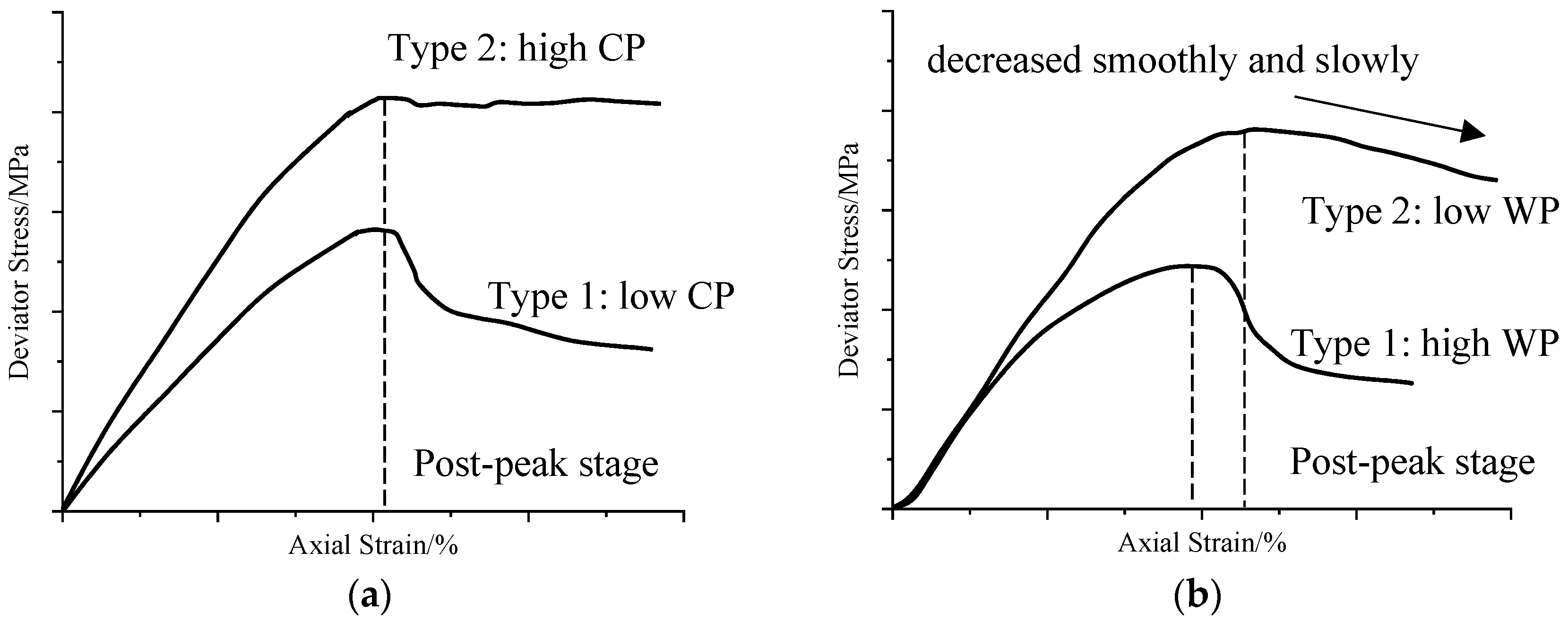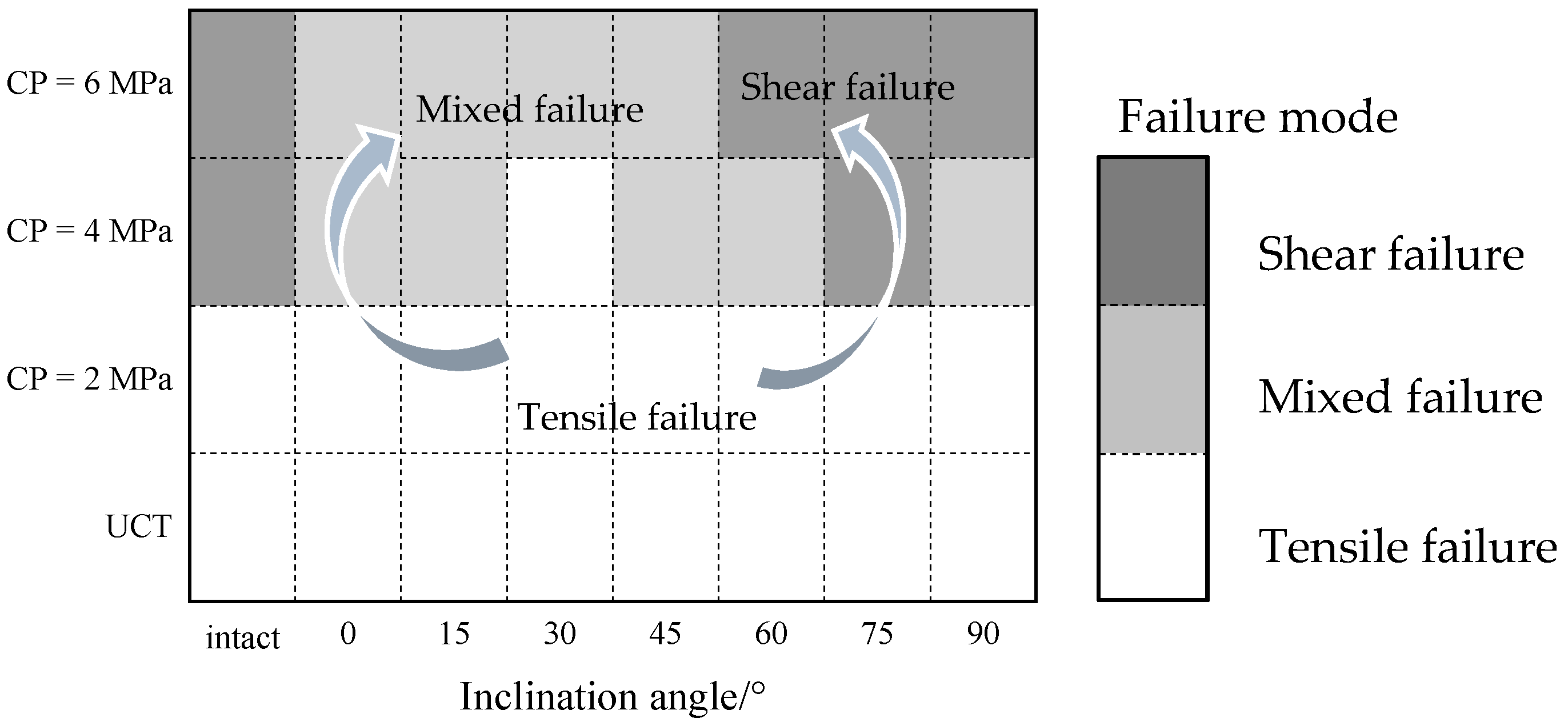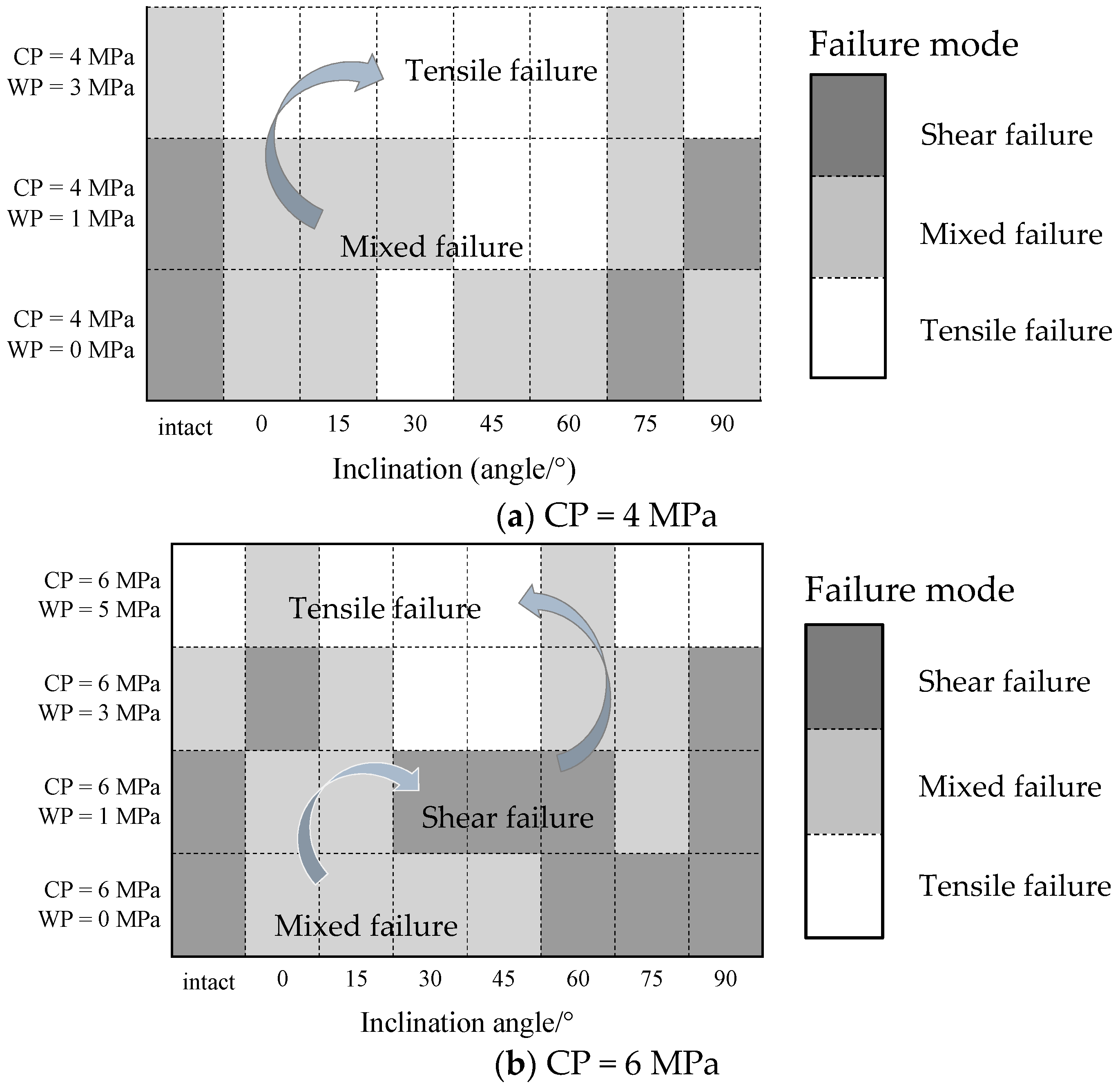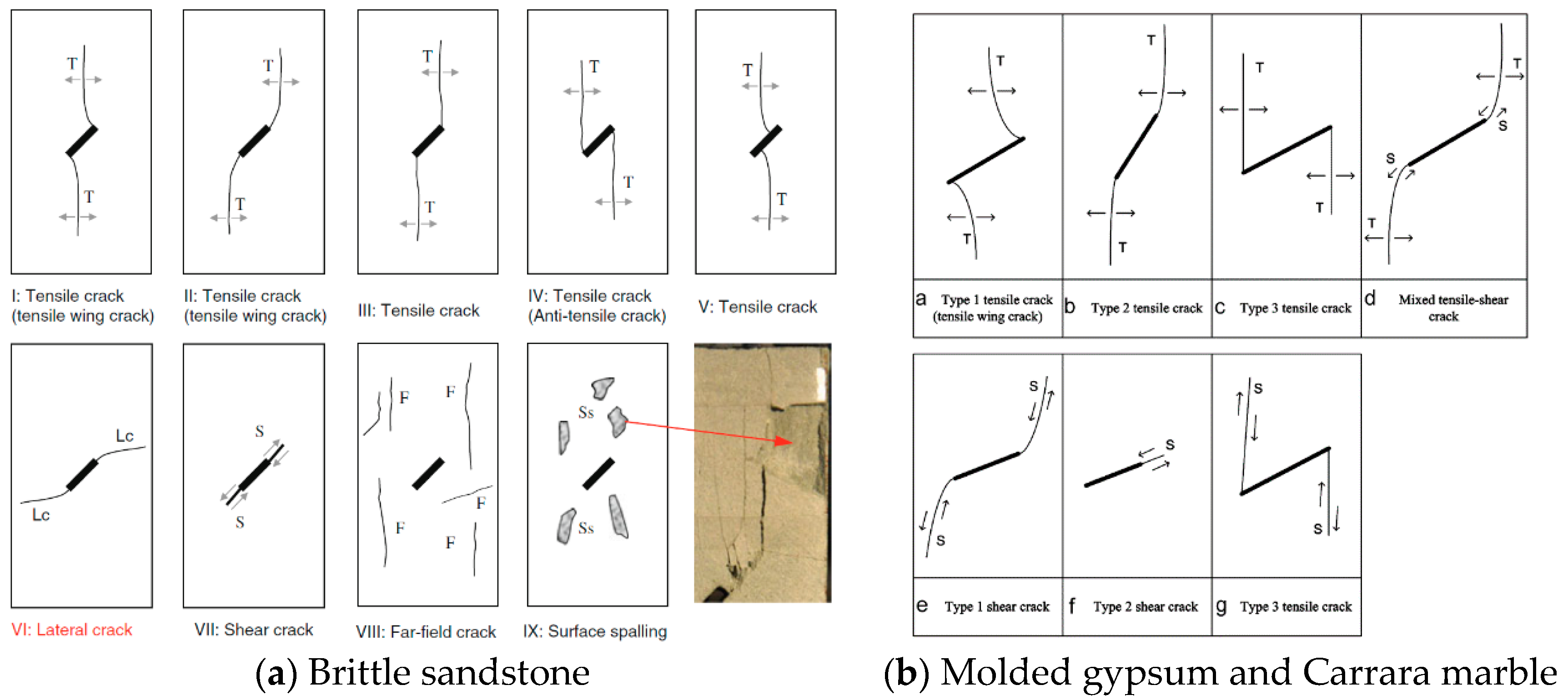Experimental Study on Rock-Like Specimens with Single Flaw under Hydro-Mechanical Coupling
Abstract
:Featured Application
Abstract
1. Introduction
2. Specimen and Testing Procedure
2.1. Specimen Preparation
2.2. Test Setup and Procedures
3. Results
3.1. Mechanical Properties
3.1.1. Stress–Strain Curve Behavior
3.1.2. Peak Deviator Stress
3.1.3. Deformation Characteristics
3.2. Observation of Crack Characteristics
3.2.1. Surface Crack Observation
3.2.2. Internal Cracks Observation Based on X-ray Computed Tomography (CT)
3.2.3. Crack Surface Observation
3.2.4. Microscope Observation Based on Scanning Electron Microscope (SEM)
3.3. Crack Types Observed in This Experiment
3.4. Effect of Confining Pressure on Cracking Behavior
3.5. Effect of Water Pressure on Cracking Behavior
3.6. Effect of Inclination Angle on Cracking Behavior
4. Discussion
5. Conclusions
- (1)
- The stress–strain curves of conventional and hydraulic coupling triaxial tests can be divided into two types according to post-peak behavior. The first type gradually declines after the peak, and the failure mode of these specimens were mostly tensile failures. The second type remained a long yield platform after the peak, and failure mode of these specimens were mostly shear failures.
- (2)
- Base on detailed macro and micro observation, nine types of cracks under hydro-mechanical coupling with different geometry and mechanisms (tensile, shear, or mixed) that led specimen failure were summarized. Though the results were obtained by macro and micro observation after failure, it still reflects the cracking behavior of jointed rock mass under hydro-mechanical coupling.
- (3)
- Specimens preferred to shear failure under high confining pressure, and the results showed confining pressure may inhibit the tensile cracks. The specimens were prone to tensile failure under high water pressure, and the results showed that water pressure may promote the tensile cracks. However, specimens preferred shear failure under high confining pressure and low water pressure, which may be because the lubrication of water reduced the resistance of the potential sliding surface, and the lubrication effect may exceed the expansion effect under that condition.
Author Contributions
Funding
Acknowledgments
Conflicts of Interest
References
- Bieniawski, Z.T. Mechanism of Brittle Fracture of Rock: Part Ii—Experimental Studies. Int. J. Rock Mech. Min. Sci. Geomech. Abstr. 1967, 4, 407–423. [Google Scholar] [CrossRef]
- Bobet, A.; Einstein, H. Fracture coalescence in rock-type materials under uniaxial and biaxial compression. Int. J. Rock Mech. Min. Sci. 1998, 35, 863–888. [Google Scholar] [CrossRef]
- Brace, W.F.; Bombolakis, E.G. A note on brittle crack growth in compression. J. Geophys. Res. Space Phys. 1963, 68, 3709–3713. [Google Scholar] [CrossRef]
- Hoek, E.; Bieniawski, Z. Brittle fracture propagation in rock under compression. Int. J. Fract. 1965, 1, 137–155. [Google Scholar] [CrossRef]
- Morgan, S.P.; Johnson, C.A.; Einstein, H.H. Cracking processes in Barre granite: Fracture process zones and crack coalescence. Int. J. Fract. 2013, 180, 177–204. [Google Scholar] [CrossRef]
- Petit, J.-P.; Barquins, M. Can natural faults propagate under Mode II conditions? Tectonics 1988, 7, 1243–1256. [Google Scholar] [CrossRef]
- Zhao, C.; Zhou, Y.M.; Zhao, C.F.; Bao, C. Cracking Processes and Coalescence Modes in Rock-Like Specimens with Two Parallel Pre-existing Cracks. Rock Mech. Rock Eng. 2018, 51, 3377–3393. [Google Scholar] [CrossRef]
- Wong, L.; Einstein, H. Systematic evaluation of cracking behavior in specimens containing single flaws under uniaxial compression. Int. J. Rock Mech. Min. Sci. 2009, 46, 239–249. [Google Scholar] [CrossRef]
- Wong LN, Y.; Einstein, H.H. Crack Coalescence in Molded Gypsum and Carrara Marble: Part 1. Macroscopic Observations and Interpretation. Rock Mech. Rock Eng. 2009, 42, 475–511. [Google Scholar] [CrossRef]
- Yang, S.Q.; Jing, H.W. Strength Failure and Crack Coalescence Behavior of Brittle Sandstone Samples Containing a Single Fissure under Uniaxial Compression. Int. J. Fract. 2011, 168, 227–250. [Google Scholar] [CrossRef]
- Miao, S.; Pan, P.Z.; Wu, Z.; Li, S.; Zhao, S. Fracture Analysis of Sandstone with a Single Filled Flaw under Uniaxial Compression. Eng. Fract. Mech. 2018, 204, 319–343. [Google Scholar] [CrossRef]
- Yang, L.; Jiang, Y.; Li, B.; Li, S.; Gao, Y. Application of the expanded distinct element method for the study of crack growth in rock-like materials under uniaxial compression. Front. Struct. Civ. Eng. 2012, 6, 121–131. [Google Scholar] [CrossRef]
- Yang, S.Q. Crack Coalescence Behavior of Brittle Sandstone Samples Containing Two Coplanar Fissures in the Process of Deformation Failure. Eng. Fract. Mech. 2011, 78, 3059–3081. [Google Scholar] [CrossRef]
- Zhao, C.; Matsuda, H.; Morita, C.; Shen, M.R. Study on Failure Characteristic of Rock-Like Materials with an Open-Hole under Uniaxial Compression. Strain 2011, 47, 405–413. [Google Scholar] [CrossRef]
- Bruning, T.; Karakuş, M.; Nguyen, G.D.; Goodchild, D. Experimental Study on the Damage Evolution of Brittle Rock Under Triaxial Confinement with Full Circumferential Strain Control. Rock Mech. Rock Eng. 2018, 51, 3321–3341. [Google Scholar] [CrossRef]
- Huang, Y.-H.; Yang, S.-Q. Mechanical and cracking behavior of granite containing two coplanar flaws under conventional triaxial compression. Int. J. Damage Mech. 2018, 28, 590–610. [Google Scholar] [CrossRef]
- Huang, Y.-H.; Zhao, J.; Yang, S.-Q. Three-Dimensional Numerical Simulation on Triaxial Failure Mechanical Behavior of Rock-Like Specimen Containing Two Unparallel Fissures. Rock Mech. Rock Eng. 2016, 49, 4711–4729. [Google Scholar] [CrossRef]
- Le, H.; Sun, S.; Xu, C.; Li, L.; Liu, Y. Cracking Behaviors and Mechanical Properties of Rock-Like Specimens with Two Unparallel Flaws under Conventional Triaxial Compression. Adv. Civ. Eng. 2019, 2019, 5849703. [Google Scholar] [CrossRef]
- Wang, S.; Sloan, S.; Sheng, D.; Yang, S.; Tang, C. Numerical study of failure behaviour of pre-cracked rock specimens under conventional triaxial compression. Int. J. Solids Struct. 2014, 51, 1132–1148. [Google Scholar] [CrossRef] [Green Version]
- Yang, S.-Q.; Huang, Y.-H. An experimental study on deformation and failure mechanical behavior of granite containing a single fissure under different confining pressures. Environ. Earth Sci. 2017, 76, 340. [Google Scholar] [CrossRef]
- Zhou, Y.; Zhao, C.; Zhao, C.; Ma, C.; Xie, J. Experimental Study on the Fracturing Behaviors and Mechanical Properties of Cracks under Coupled Hydro-Mechanical Effects in Rock-Like Specimens. Water 2018, 10, 1355. [Google Scholar] [CrossRef]
- Nabawy, B.S.; David, C. X-Ray CT scanning imaging for the Nubia sandstone as a tool for characterizing its capillary properties. Geosci. J. 2016, 20, 691–704. [Google Scholar] [CrossRef]
- Xu, J.; Zhou, R.; Song, D.; Li, N.; Zhang, K.; Xi, D. Deformation and Damage Dynamic Characteristics of Coal-Rock Materials in Deep Coal Mines. Int. J. Damage Mech. 2019, 28, 58–78. [Google Scholar] [CrossRef]
- Zhao, G.-F.; Russell, A.R.; Zhao, X.; Khalili, N. Strain rate dependency of uniaxial tensile strength in Gosford sandstone by the Distinct Lattice Spring Model with X-ray micro CT. Int. J. Solids Struct. 2014, 51, 1587–1600. [Google Scholar] [CrossRef] [Green Version]
- Zhou, X.; Zhang, Y.; Ha, Q. Real-time computerized tomography (CT) experiments on limestone damage evolution during unloading. Theor. Appl. Fract. Mech. 2008, 50, 49–56. [Google Scholar] [CrossRef]
- Andreani, M.; Baronnet, A.; Boullier, A.M.; Gratier, J.P. A microstructural study of a “crack-seal” type serpentine vein using SEM and TEM techniques. Eur. J. Miner. 2004, 16, 585–595. [Google Scholar] [CrossRef]
- Cui, Z.; Han, W. In Situ Scanning Electron Microscope (SEM) Observations of Damage and Crack Growth of Shale. Microsc. Microanal. 2018, 24, 107–115. [Google Scholar] [CrossRef]
- Liu, Q.; Liu, Q.; Pan, Y.; Liu, X.; Kong, X.; Deng, P. Microcracking Mechanism Analysis of Rock Failure in Diametral Compression Tests. J. Mater. Civ. Eng. 2018, 30, 04018082. [Google Scholar] [CrossRef]
- Zhao, Y.; Huang, J.; Wang, R. Real-time SEM observations of the microfracturing process in rock during a compression test. Int. J. Rock Mech. Min. Sci. Géoméch. Abstr. 1993, 30, 643–652. [Google Scholar] [CrossRef]
















| Experimental Type | Specimen Number | Specimen | Confining Pressure | Water Pressure |
|---|---|---|---|---|
| Uniaxial compression test | Intact, and 0°, 15°, 30°, 45°, 60°, 75°, 90° specimens | - | - | |
| Triaxial compression test | 2, 4, 6 MPa | - | ||
| Hydraulic coupled triaxial test | 2 MPa | 1 MPa | ||
| 4 MPa | 1, 3 MPa | |||
| 6 MPa | 1, 3, 5 MPa |
| Specimens | Uniaxial | Triaxial | ||
|---|---|---|---|---|
| CP = 2 MPa | CP = 4 MPa | CP = 6 MPa | ||
| Intact specimen | T3 | T3 | S2 | S2 |
| 0° specimen | T1, T2 | T3 | M3 | M3 |
| 15° specimen | T1 | T1 | M3 | M3 |
| 30° specimen | T1, T2 | T3 | T3, T1 | M2 |
| 45° specimen | T1 | T3 | M1, M2 | M1 |
| 60° specimen | T1 | T3, T1 | M2 | S1 |
| 75° specimen | T1, T2 | T3 | S2 | S1 |
| 90° specimen | T3 | T3 | M3 | S2 |
| Notes | T1: type 1 tensile crack | S2: type 2 shear crack | ||
| T2: type 2 tensile crack | M1: type 1 mixed crack | |||
| T3: type 3 tensile crack | M2: type 2 mixed crack | |||
| S1: type 1 shear crack | M3: type 3 mixed crack | |||
| Specimens | CP = 2 MPa | CP = 4 MPa | CP = 6 MPa | |||
|---|---|---|---|---|---|---|
| WP = 1 MPa | WP = 1 MPa | WP = 3 MPa | WP = 1 MPa | WP = 3 MPa | WP = 5 MPa | |
| Intact specimen | S2 | S2 | M3 | S2 | M1 | T3 |
| 0° specimen | T1 | M3 | T1 | M2, S2 | S2 | M2 |
| 15° specimen | T1 | M3 | T3 | M2 | M2 | HCC, M2 |
| 30° specimen | T3, T1 | M3 | T3 | S1 | T3 | HCC, T3 |
| 45° specimen | T3 | T3 | HCC, M1 | S1 | T3 | HCC, M2 |
| 60° specimen | T3 | T3 | T3 | S1 | M1 | M1 |
| 75° specimen | M3 | M1 | M1 | M2 | M2 | T3 |
| 90° specimen | T3 | S2 | T3 | S1 | S2 | T3 |
| Note | The marks have the same meaning as Table 2. | |||||
© 2019 by the authors. Licensee MDPI, Basel, Switzerland. This article is an open access article distributed under the terms and conditions of the Creative Commons Attribution (CC BY) license (http://creativecommons.org/licenses/by/4.0/).
Share and Cite
Xing, J.; Zhao, C.; Yu, S.; Matsuda, H.; Ma, C. Experimental Study on Rock-Like Specimens with Single Flaw under Hydro-Mechanical Coupling. Appl. Sci. 2019, 9, 3234. https://doi.org/10.3390/app9163234
Xing J, Zhao C, Yu S, Matsuda H, Ma C. Experimental Study on Rock-Like Specimens with Single Flaw under Hydro-Mechanical Coupling. Applied Sciences. 2019; 9(16):3234. https://doi.org/10.3390/app9163234
Chicago/Turabian StyleXing, Jinquan, Cheng Zhao, Songbo Yu, Hiroshi Matsuda, and Chuangchuang Ma. 2019. "Experimental Study on Rock-Like Specimens with Single Flaw under Hydro-Mechanical Coupling" Applied Sciences 9, no. 16: 3234. https://doi.org/10.3390/app9163234
APA StyleXing, J., Zhao, C., Yu, S., Matsuda, H., & Ma, C. (2019). Experimental Study on Rock-Like Specimens with Single Flaw under Hydro-Mechanical Coupling. Applied Sciences, 9(16), 3234. https://doi.org/10.3390/app9163234





